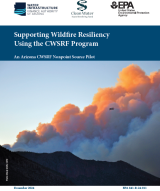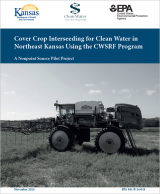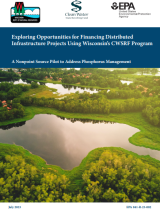Funding Resources for Watershed Protection and Restoration
On this page:
- Leveraging Nonpoint Source Funding with State Revolving Funds (SRFs)
- Federal Funding Resources
- Additional Resources
Leveraging Nonpoint Source Funding with State Revolving Funds (SRFs)
The Clean Water SRF (CWSRF) program is a federal-state partnership that provides low-cost financing to communities for a wide range of water quality infrastructure projects. Similarly, the Drinking Water SRF (DWSRF) is a federal-state partnership financial assistance program to help water systems and states to achieve the health protection objectives of the Safe Drinking Water Act. Both CWSRF and DWSRF programs can be used to help address priority nonpoint source needs. These resources can show you how.
General Resources
- CWSRF Best Practices Guide for Financing Nonpoint Source Solutions (pdf) This guide is designed to help the 51 state-level CWSRF programs apply best practices to address the challenge of nonpoint source (NPS) pollution. Some of the programs have achieved notable success using CWSRF funds to target NPS needs. These state programs have evolved to produce creative solutions to combat NPS problems and offer valuable lessons for other states to consider. EPA developed this guide to share the collective wisdom from those states. The guide will help state staff better align and integrate their state’s CWSRF and NPS management programs. The guide suggests strategies and key elements needed to expand the use of CWSRF resources to address priority needs as specified in state NPS management program plans, and it identifies potential obstacles and how to overcome them. The guide provides helpful case studies of successful and innovative partnerships underway across the country.
- Watershed Financing Partnerships (pdf) This fact sheet describes how CWSRF funds can be used to help support watershed-scale investments in water quality through the formation of watershed financing partnerships. It outlines how to develop a CWSRF-supported watershed financing partnership and highlights successful examples in South Dakota and Pennsylvania.
- Financing Options for Nontraditional Eligibilities in the Clean Water State Revolving Funds Program (pdf) This technical reference looks at the varied types of financial assistance available to the CWSRF programs that can be deployed to fund eligibilities that do not fall within the mainstream of traditional grey infrastructure and is therefore particularly useful for financing nonpoint source projects.
- CWSRF Webinar Series - This series includes webinars on sponsorship lending for NPS and using the CWSRF to fund land conservation, decentralized wastewater and urban tree canopy.
- Financing Green Infrastructure: Best Practices Guide for Clean Water State Revolving Fund (pdf) This 10-page quick guide provides an overview on ways to use the CWSRF to address green infrastructure needs by covering the why, where, and how.
- Funding Agricultural Best Management Practices with the Clean Water State Revolving Fund (pdf) This fact sheet demonstrates how the Clean Water State Revolving Fund provides assistance to eligible recipients for projects promoting agricultural best management practices. It also gives an overview of the Maryland and Virginia Farm Credit Banks, as well as the Minnesota Ag BMP Loan Program.
-
Financing Decentralized Wastewater Treatment Systems: Pathways to Success with the Clean Water State Revolving Fund (pdf)
This guide is for local and state onsite/decentralized wastewater programs and community leaders to learn ways to access CWSRF financing. It describes CWSRF program basics, requirements, alternative financing structures, and mechanisms to effectively reach prospective borrowers to repair, construct, or replace their decentralized wastewater systems. This guide may also assist CWSRF state program staff who have never financed decentralized system projects to begin, or expand, their assistance to include such projects. This guide provides the tools and knowledge necessary to successfully navigate the financing process and to understand the basics of alternative CWSRF financing structures.
- Financing Decentralized Treatment Systems Fact Sheet (pdf) (1.6 MB, June 2016) This fact sheet is a companion piece to the above guide. The fact sheet highlights the major sections of the guide and is a useful tool to hand out to local stakeholders and leaders to get a general sense of how to finance decentralized wastewater systems through the CWSRF.
- FITS: Funding Integration Tool for Source Water - FITS is a one-stop-shop tool that explains how users can integrate various federal funding sources to support activities that protect sources of drinking water.
- Sponsorship Lending and the Clean Water State Revolving Fund (pdf) This fact sheet demonstrates how the CWSRF provides assistance to eligible recipients through sponsorship lending. It highlights successful projects in Idaho and Iowa.
- Protecting Source Water with the DWSRF Set-Asides (pdf) This fact sheet describes DWSRF eligibilities related to source water protection (SWP). It provides several case studies where DWSRF set-asides were used for SWP-related activities.
- Protecting Source Water with the Clean Water State Revolving Fund (pdf) CWSRF financing is available to public, private, or nonprofit entities for many types of SWP projects, including both green and grey infrastructure water quality solutions for both surface water and groundwater. This fact sheet demonstrates how the CWSRF provides assistance to eligible recipients for SWP activities.
State Specific Case Studies
-

Supporting Wildfire Resiliency Using the CWSRF Program: An Arizona CWSRF Nonpoint Source Pilot (pdf) In 2019-2020, the EPA provided technical assistance to Arizona’s CWSRF Program to reduce wildfire risk in high priority drinking water supply watersheds. As a result, the Arizona Water Infrastructure Finance Authority WIFA) created the Forest Thinning and Wildfire Restoration Program and worked with the City of Flagstaff to provide a $6 million loan for forest thinning projects to reduce the potential for flash flood and mudslides that can pollute drinking water resources critically needed in drought-stricken areas. WIFA used the technical assistance to develop marketing materials including an interactive triple bottom line tool that makes the business case for investing in wildfire resiliency projects. The tool produces community-specific measurable benefits and costs avoided by undertaking proactive forest management projects through CWSRF loans.
- Supporting Healthy Watersheds in the West: Arizona's Forest Thinning & Wildfire Restoration Program (pdf) A four-page fact sheet to highlight this use of CWSRF financing to address resiliency, innovative financing and marketing in the face of expanding drought conditions.

- Cover Crop Interseeding for Clean Water in Northeast Kansas Using CWSRF Program (pdf) In 2019, the EPA provided technical assistance to help Kansas use a $3.5 million CWSRF loan to purchase critical farm equipment to significantly scale up the use of cover crops in priority watersheds. The cover crops are restoring soil health and reversing negative water quality impacts from traditional row crop agriculture. The loan million was used to purchase a fleet of eight “high boy” interseeders, with commitments for each machine to be used to plant at least 10,000 acres of cover crops each year in two critical watersheds. As a result, soil health and crop yields have been steadily improving over time while excess nitrogen, phosphorus and sediment are being significantly curtailed. Additionally, the loan was credited toward the federally required green project reserve under the water conservation eligibility because cash crops grown in restored organic-rich soil requires less artificial irrigation.
-

Scaling Up Ecosystem Restoration Efforts to Improve Water Quality in the Chesapeake Bay - Maryland's CWSRF Nonpoint Source Pilot (pdf) In 2020-2021, the EPA provided technical assistance to help Maryland use its CWSRF program to incentivize reforestation on private lands. The case study report lays out the “road map” that Maryland followed and presents a tool developed to calculate co-benefits of reforestation and restoration credits for stormwater permits to assist local governments and partners seeking loans to fund forestry efforts. The report also highlights how the state CWSRF program partnered with other programs and used the power of loan guarantees to expand the reach and effectiveness to support this use of CWSRF resources.
-

Exploring Opportunities for Financing Distributed Infrastructure Projects Using Wisconsin's CWSRF Program - A Nonpoint Source Pilot to Address Phosphorus Management (pdf) In 2021-2022, the EPA worked with Wisconsin’s CWSRF program to facilitate greater investments in NPS projects, such as agricultural BMPs and urban green infrastructure practices, as cost-effective alternatives to traditional point source projects for reducing phosphorus pollution in lakes and other water bodies. Wisconsin used EPA’s assistance to develop a strategy that would allow a wastewater utility to invest in a water quality trading approach for meeting a phosphorus reduction target by bundling together disparate NPS projects distributed throughout a watershed, all within a single loan agreement. This watershed financing partnership strategy offers a low-cost and comprehensive way for public utilities to easily finance a wide range of projects that leverage many partners throughout a watershed using a mechanism known as programmatic financing. This approach is likely to reduce phosphorus more cost-effectively in state waters when compared with a point source-only approach for meeting nutrient reduction targets.
- CWSRF Project Case Studies Database – Explore a searchable database of 240 water quality case studies from the EPA CWSRF Fact Sheets and the PISCES recognition program that State CWSRF programs have funded. The 27 project categories on the page include many nonpoint source activities.
Federal Funding Resources
Understanding Managing and Applying for EPA Grants: Includes information on how to apply, grant resources, grant programs and more.
The Water Finance Clearing House: A searchable database of financial assistance sources (grants, loans, cost-sharing) available from federal agencies including those to fund a variety of watershed protection projects.
Grants.gov: This website provides organizations with the ability to search for competitive grants from all grant-making federal agencies, register to receive grant notices via e-mail, and download grant applications.
Water Infrastructure and Resiliency Finance Center: provides financial expertise to communities that are financing drinking water, waste water, and/or stormwater infrastructure projects.
Water Quality Management Planning Grants: Information on Section 604(b) of the Clean Water Act, which provides approximately 1% of SRF allotments to support State water quality planning activities.
Environmental Education Grants Program: This program supports environmental education projects that increase the public awareness about environmental issues and increase people's ability to make informed decisions that impact environmental quality. EPA awards between $2 and $3 million annually. More than 75 percent of these grant recipients receive less than $15,000.
Additional Funding Resources
Environmental Finance Centers (EFCs) are technical assistance providers that help communities develop and submit project proposals, including State Revolving Fund (SRF) applications for Infrastructure Investment and Jobs Act funding. EFCs can support underserved communities with technical assistance to identify sustainable infrastructure solutions. These entities provide states, Tribes, and local governments with technical assistance services to advance equitable health and environmental protections. As of November 2022, there are 29 EFCs in this network.
Chesapeake Bay Funders Network creates opportunities for funding organizations to make a real difference by providing current and objective information on policy issues by helping organizations focus on the most pressing Chesapeake Bay and watershed problems, and providing networking opportunities to foster collaborations and shared interests and activities.
